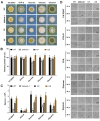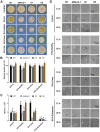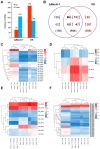Transcription Factor Mavib-1 Negatively Regulates Conidiation by Affecting Utilization of Carbon and Nitrogen Source in Metarhizium acridum
- PMID: 35736077
- PMCID: PMC9224900
- DOI: 10.3390/jof8060594
Transcription Factor Mavib-1 Negatively Regulates Conidiation by Affecting Utilization of Carbon and Nitrogen Source in Metarhizium acridum
Abstract
Conidium is the main infection unit and reproductive unit of pathogenic fungi. Exploring the mechanism of conidiation and its regulation contributes to understanding the pathogenicity of pathogenic fungi. Vib-1, a transcription factor, was reported to participate in the conidiation process. However, the regulation mechanism of Vib-1 in conidiation is still unclear. In this study, we analyzed the function of Vib-1 and its regulation mechanism in conidiation through knocking out and overexpression of Vib-1 in entomopathogenic fungus Metarhizium acridum. Results showed that the colonial growth of Mavib-1 disruption mutant (ΔMavib-1) was significantly decreased, and conidiation was earlier compared to wild type (WT), while overexpression of Mavib-1 led to a delayed conidiation especially when carbon or nitrogen sources were insufficient. Overexpression of Mavib-1 resulted in a conidiation pattern shift from microcycle conidiation to normal conidiation on nutrient-limited medium. These results indicated that Mavib-1 acted as a positive regulator in vegetative growth and a negative regulator in conidiation by affecting utilization of carbon and nitrogen sources in M. acridum. Transcription profile analysis demonstrated that many genes related to carbon and nitrogen source metabolisms were differentially expressed in ΔMavib-1 and OE strains compared to WT. Moreover, Mavib-1 affects the conidial germination, tolerance to UV-B and heat stresses, cell wall integrity, conidial surface morphology and conidial hydrophobicity in M. acridum. These findings unravel the regulatory mechanism of Mavib-1 in fungal growth and conidiation, and enrich the knowledge to conidiation pattern shift of filamentous fungi.
Keywords: carbon and nitrogen utilization; conidiation; entomopathogenic fungi; transcription factor Mavib-1.
Conflict of interest statement
The authors declare no conflict of interest.
Figures






Similar articles
-
Tetracarboxylic acid transporter regulates growth, conidiation, and carbon utilization in Metarhizium acridum.Appl Microbiol Biotechnol. 2023 May;107(9):2969-2982. doi: 10.1007/s00253-023-12471-x. Epub 2023 Mar 21. Appl Microbiol Biotechnol. 2023. PMID: 36941435
-
The MaCreA Gene Regulates Normal Conidiation and Microcycle Conidiation in Metarhizium acridum.Front Microbiol. 2019 Aug 21;10:1946. doi: 10.3389/fmicb.2019.01946. eCollection 2019. Front Microbiol. 2019. PMID: 31497008 Free PMC article.
-
MaSln1, a Conserved Histidine Protein Kinase, Contributes to Conidiation Pattern Shift Independent of the MAPK Pathway in Metarhizium acridum.Microbiol Spectr. 2022 Apr 27;10(2):e0205121. doi: 10.1128/spectrum.02051-21. Epub 2022 Mar 28. Microbiol Spectr. 2022. PMID: 35343772 Free PMC article.
-
Microcyle conidiation in filamentous fungi.Mycobiology. 2014 Mar;42(1):1-5. doi: 10.5941/MYCO.2014.42.1.1. Epub 2014 Mar 31. Mycobiology. 2014. PMID: 24808726 Free PMC article. Review.
-
New Downstream Signaling Branches of the Mitogen-Activated Protein Kinase Cascades Identified in the Insect Pathogenic and Plant Symbiotic Fungus Metarhizium robertsii.Front Fungal Biol. 2022 May 30;3:911366. doi: 10.3389/ffunb.2022.911366. eCollection 2022. Front Fungal Biol. 2022. PMID: 37746179 Free PMC article. Review.
Cited by
-
The Virulence of Metarhizium rileyi to Locusta migratoria Is Determined by the Ability of the Fungus to Respond to Carbon and Nitrogen Sources.Int J Mol Sci. 2025 Apr 27;26(9):4156. doi: 10.3390/ijms26094156. Int J Mol Sci. 2025. PMID: 40362396 Free PMC article.
-
The Forkhead Box Gene, MaSep1, Negatively Regulates UV- and Thermo-Tolerances and Is Required for Microcycle Conidiation in Metarhizium acridum.J Fungi (Basel). 2024 Aug 2;10(8):544. doi: 10.3390/jof10080544. J Fungi (Basel). 2024. PMID: 39194870 Free PMC article.
-
Melanin in fungi: advances in structure, biosynthesis, regulation, and metabolic engineering.Microb Cell Fact. 2024 Dec 19;23(1):334. doi: 10.1186/s12934-024-02614-8. Microb Cell Fact. 2024. PMID: 39696244 Free PMC article. Review.
References
-
- Zhang S.Z., Peng G.X., Xia Y.X. Microcycle conidiation and the conidial properties in the entomopathogenic fungus Metarhizium acridum on agar medium. Biocontrol Sci. Technol. 2010;20:809–819. doi: 10.1080/09583157.2010.482201. - DOI
-
- De Faria M.R., Wraight S.P. Mycoinsecticides and mycoacaricides: A comprehensive list with worldwide coverage and international classification of formulation types. Biol. Control. 2007;43:237–256. doi: 10.1016/j.biocontrol.2007.08.001. - DOI
Grants and funding
LinkOut - more resources
Full Text Sources

